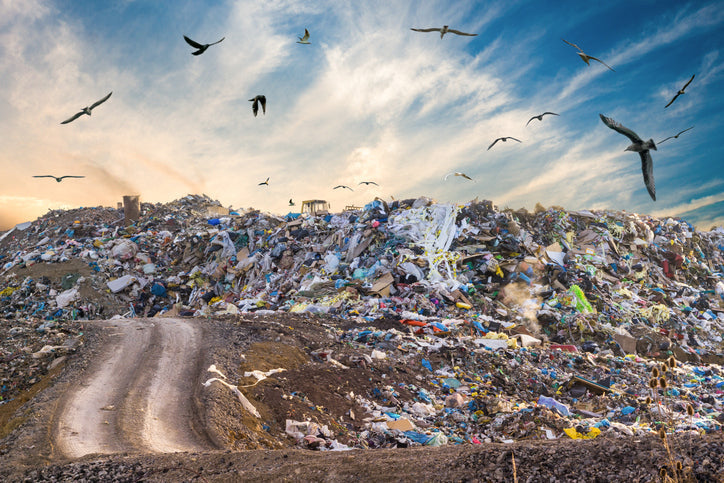
The Environmental Impact of Disposable Diapers in Our Landfills
|
|
Time to read 5 min
|
|
Time to read 5 min
This page will explore the scale of the impact of disposable diapers, their decomposition timeline, and the strategies being explored to mitigate their environmental impact.
Disposable diapers are one of the most common items found in landfills today. In the United States alone, an estimated 20 billion disposable diapers are discarded annually[1]. This means around 54.8 million disposable diapers being thrown away per day in the US. Or about 3.75 million tons of diaper waste per year [2]. Globally, the numbers are even more staggering—it is estimated that over 200 billion disposable diapers are used and discarded worldwide each year[3].
The sheer volume of disposable diapers ending up in landfills is problematic for several reasons. Firstly, the materials used to manufacture disposable diapers, including plastic, wood pulp, and absorbent gels, do not readily decompose[1]. This means the diapers can persist in landfills for decades, if not centuries, taking up valuable space.
Additionally, many of those disposable diapers are discarded with human fecal matter wrapped tightly inside. If the feces are not removed from the diaper before disposal, the fecal contents can leach out into groundwater. This is especially true at older landfills.
Disposable diapers are produced through a multi-step automated process.
According to the Environmental Protection Agency (EPA), a disposable diaper can take up to 450 years to decompose in a landfill environment[1]. This is due to the complex composition of disposable diapers, which typically include:
The anaerobic (oxygen-free) conditions found in modern landfills further slow the decomposition process, as microorganisms responsible for breaking down organic matter are unable to thrive[4]. This means that diapers discarded today will likely still be present in landfills long after the current generation has passed.
The sheer volume and slow decomposition of disposable diapers in landfills contribute to several environmental concerns:
In response to the growing concerns over the environmental impact of disposable diapers, several strategies have been explored to reduce their footprint:
The environmental impact of disposable diapers in landfills is a significant and growing concern. The sheer volume of diapers discarded each year, coupled with their slow decomposition timeline, contributes to land use challenges, greenhouse gas emissions, and potential contamination of local ecosystems. While various strategies have been explored to mitigate these impacts, from improved recycling and composting to the promotion of reusable alternatives, the scale of the problem remains daunting.
Addressing the environmental toll of disposable diapers will require a multi-faceted approach, involving collaboration between manufacturers, policymakers, waste management authorities, and consumers. By raising awareness, investing in innovative solutions, and implementing targeted policies, we can work towards a more sustainable future for diaper disposal and waste management as a whole.
Citations:
[1] Environmental Protection Agency. (2013). The Quest for Less: Activities and Resources for Teaching K-8. [PDF] Retrieved from https://www.epa.gov/sites/default/files/2015-09/documents/qfl_complete.pdf
[2] Statista. (2022). Estimated number of disposable diapers used in the United States from 2004 to 2024. Retrieved from https://www.statista.com/statistics/282732/us-disposable-diaper-usage/
[3] Transparency Market Research. (2022). Disposable Diapers Market - Global Industry Analysis, Size, Share, Growth, Trends, and Forecast, 2022-2031. Retrieved from https://www.transparencymarketresearch.com/disposable-diapers-market.html
[4] Rathje, W., & Murphy, C. (2001). Rubbish!: The Archaeology of Garbage. University of Arizona Press.
[5] Hoornweg, D., & Bhada-Tata, P. (2012). What a Waste: A Global Review of Solid Waste Management. World Bank.
Bogner, J., Abdelrafie Ahmed, M., Diaz, C., Faaij, A., Gao, Q., Hashimoto, S., ... & Zhang, T. (2007). Waste management. In Climate Change 2007: Mitigation. Contribution of Working Group III to the Fourth Assessment Report of the Intergovernmental Panel on Climate Change.
Kjeldsen, P., Barlaz, M. A., Rooker, A. P., Baun, A., Ledin, A., & Christensen, T. H. (2002). Present and long-term composition of MSW landfill leachate: a review. Critical reviews in environmental science and technology, 32(4), 297-336.
Muthu, S. S. (Ed.). (2014). Assessing the environmental impact of textiles and the clothing supply chain. Elsevier.
Recycling Today. (2019). Diaper recycling pilot launches in Canada. Retrieved from https://www.recyclingtoday.com/article/diaper-recycling-pilot-launches-in-canada/
Kimberly-Clark. (2022). Sustainability. Retrieved from https://www.kimberly-clark.com/en/sustainability
Real Diaper Association. (2022). Benefits of Cloth Diapers. Retrieved from https://realdiaperassociation.org/diaper-facts/benefits-of-cloth-diapers/
EPA. (2022). Reduce, Reuse, Recycle. Retrieved from https://www.epa.gov/recycle
Waste Dive. (2022). Seattle bans disposable diapers in city facilities. Retrieved from https://www.wastedive.com/news/seattle-bans-disposable-diapers-in-city-facilities/628847/

